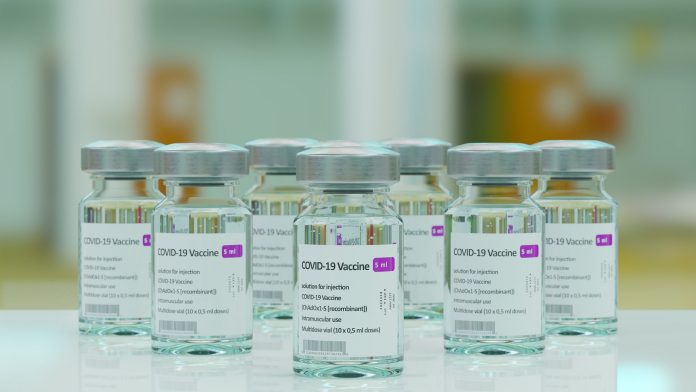سه آدنوویروس که به عنوان ناقل برای تولید واکسنهای کووید-19 استفاده میشوند، به فاکتور پلاکت 4 (PF4) متصل میشوند، پروتئینی که در پاتوژنز اختلالات انعقادی نقش دارد.
Adenovirus based COVID-19 واکسن such as Oxford/AstraZeneca’s ChAdOx1 use the weakened and genetically modified version of common cold ویروس adenovirus (a DNA ویروس) as vector for expression of viral protein of novel coronavirus nCoV-2019 in the human body. The expressed viral protein in turn act as antigen for development of active immunity. The adenovirus used is replication incompetent meaning it cannot replicate in human body but as vector it provides an opportunity for translation of incorporated gene encoding Spike protein (S) of novel قرنطینه1. Other vectors such as human آدنوویروس type 26 (HAdV-D26; used for Janssen COVID vaccine), and human آدنوویروس type 5 (HAdV-C5) have also been used to generate واکسن against SARS-CoV-2.
واکسن کووید-19 آکسفورد/آسترازنکا (ChAdOx1 nCoV-2019) در آزمایشهای بالینی مؤثر بود و توسط تنظیمکنندهها در چندین کشور تأیید شد (در 30 دسامبر 2020 تأییدیه MHRA در بریتانیا را دریافت کرد). برخلاف سایر واکسنهای کووید-۱۹ (واکسن mRNA) موجود در آن زمان، تصور میشد این واکسن از نظر ذخیرهسازی و تدارکات دارای مزیت نسبی است. به زودی این واکسن به واکسن اصلی در مبارزه با بیماری همه گیر در سراسر جهان تبدیل شد و کمک های قابل توجهی در محافظت از مردم در سراسر جهان در برابر COVID-19 کرد.
However, a possible link between AstraZeneca’s COVID-19 vaccine and blood clot was suspected when about 37 cases of rare event of blood clots were reported (out of more than 17 million people vaccinated) in the EU and Britain. In light of this possible side effect, subsequently, Pfizer’s or Moderna’s mRNA واکسن were recommended2 for use in those under 30. But how rare clotting disorders such as thrombocytopenia syndrome (TTS), a condition resembling heparin-induced thrombocytopenia (HIT) seen in people administered with AstraZeneca COVID-19 vaccine which uses the ChAdOx1 (chimpanzee آدنوویروس Y25) vector is caused and the underlying mechanism involved, remained unclear.
A recent study published in Science Advances by Alexander T. Baker et al. demonstrates that the three آدنوویروس ها used as vectors to produce SARS-CoV-2 واکسن, bind to platelet factor 4 (PF4), a protein implicated in the pathogenesis of HIT as well as TTS.
Using a technique known as SPR (Surface Plasmon Resonance), it was shown that PF4 binds not only with pure vector preparations of these vectors, but also with واکسن derived from these vectors, with similar affinity. This interaction is due to the presence of strong electropositive surface potential in PF4 which helps in binding to the overall strong electronegative potential on the adenoviral vectors. In case of administration of the ChAdOx1 covid vaccine, the vaccine injected into the muscle may leak into the bloodstream, leading to formation of ChAdOx1/PF4 complex as described above. In rare cases, the body recognizes this complex as foreign ویروس and triggers formation of PF4 antibodies. The release of PF4 antibodies further leads to aggregation of PF4, thereby forming blood clots, lead to further complications and in certain cases, death of the patient. This has so far resulted in 73 deaths out of the nearly 50 million vaccine doses of AstraZeneca vaccine that have been given in the UK.
اثر TTS مشاهده شده پس از اولین دوز واکسن به جای دوز دوم برجسته تر است، که نشان می دهد آنتی بادی های ضد P4 ممکن است طولانی مدت نباشند. کمپلکس ChAdOx-1/PF4 با حضور هپارین که نقش کلیدی در HIT بازی می کند، مهار می شود. هپارین به چندین نسخه از پروتئین P4 متصل می شود و با آنتی بادی های ضد P4 توده هایی را تشکیل می دهد که فعال شدن پلاکت ها را تحریک می کند و در نهایت منجر به لخته شدن خون می شود.
These rare life-threatening events suggest that there is a need to engineer carrier ویروس ها in such a manner, so as to avoid any interactions with cellular proteins that can lead to SARs (Severe Adverse Reactions), thereby leading to death of the patient. Furthermore, one can look at alternative strategies to design واکسن based on protein sub-units rather than DNA.
***
منابع:
- واکسن کووید-19 آکسفورد/آسترازنکا (ChAdOx1 nCoV-2019) مؤثر و تأیید شد. علمی اروپایی منتشر شده در 30 دسامبر 2020. موجود در http://scientificeuropean.co.uk/covid-19/oxford-astrazeneca-covid-19-vaccine-chadox1-ncov-2019-found-effective-and-approved/
- Soni R. 2021. ارتباط احتمالی بین واکسن کووید-19 AstraZeneca و لختههای خون: زیر 30 سال باید واکسن mRNA Pfizer یا Moderna داده شود. علمی اروپایی منتشر شده در 7 آوریل 2021. موجود در http://scientificeuropean.co.uk/covid-19/possible-link-between-astrazenecas-covid-19-vaccine-and-blood-clots-under-30s-to-be-given-pfizers-or-modernas-mrna-vaccine/
- Baker AT, و همکاران 2021. ChAdOx1 با CAR و PF4 با پیامدهایی برای ترومبوز همراه با سندرم ترومبوسیتوپنی تعامل دارد. پیشرفت علم جلد 7، شماره 49. منتشر شده در 1 دسامبر 2021. DOI: https//doi.org/10.1126/sciadv.abl8213
***






































